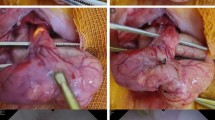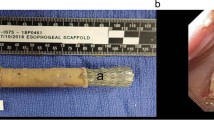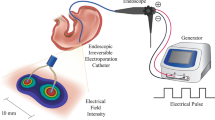Abstract
Adenoviral gene therapy could potentially be used for treatment of patients with a Barrett's esophagus. In order to study the feasibility of this approach it is important to study adenoviral intestinal transduction both in vitro and in vivo. In the present study, we used differentiating Caco-2 cells, closed intestinal loops and a Barrett's esophagus rat model to test transduction of adenoviruses expressing green fluorescent protein. We observed a decreased adenoviral transduction from 18.6 to 2.3% in undifferentiated and differentiated Caco-2 cells, respectively. This could be improved by the use of the mucolytic agent N-acetylcysteine (NAC) and the polycation diethylaminoethyl-dextran (DEAE-dextran), which improved transduction in differentiated cells five- and ten-fold, respectively. Also an RGD-retargeted adenovirus showed an improved transduction in differentiated cells. In closed intestinal loops adenoviral transduction was limited and the use of NAC and DEAE-dextran or RGD targeting had little effect. The Barrett's esophagus rat model consisted of an esophagojejunostomy, which results in a Barrett's esophagus and esophageal tumors within 6 months. Adenoviral transduction in this model was limited and mainly localized in the basal layer of normal esophagus and stromal tissue of a Barrett's segment. We conclude that although the adenovirus shows promising results in vitro, the current adenoviral vectors are probably not suitable for patients with Barrett's esophagus.
This is a preview of subscription content, access via your institution
Access options
Subscribe to this journal
Receive 12 print issues and online access
$259.00 per year
only $21.58 per issue
Buy this article
- Purchase on Springer Link
- Instant access to full article PDF
Prices may be subject to local taxes which are calculated during checkout







Similar content being viewed by others
References
Cameron AJ, Ott BJ, Payne WS . The incidence of adenocarcinoma in columnar-lined (Barrett's) esophagus. N Engl J Med. 1985;313:857–859.
Devesa SS, Blot WJ, Fraumeni Jr JF . Changing patterns in the incidence of esophageal and gastric carcinoma in the United States. Cancer. 1998;83:2049–2053.
Sharma P . An update on strategies for eradication of Barrett's mucosa. Am J Med. 2001;111 (Suppl 8A): 147S–152S.
Schmid RM, Weidenbach H, Draenert GF, et al. Liposome mediated gene transfer into the rat oesophagus. Gut. 1997; 41:549–556.
Hidalgo IJ, Raub TJ, Borchardt RT . Characterization of the human colon carcinoma cell line (Caco-2) as a model system for intestinal epithelial permeability. Gastroenterology. 1989;96:736–749.
Meunier V, Bourrie M, Berger Y, et al. The human intestinal epithelial cell line Caco-2; pharmacological and pharmacokinetic applications. Cell Biol Toxicol. 1995;11: 187–194.
Hulscher JB, Buskens CJ, Huyzer G, et al. An animal model for Barrett's oesophagus but not for Barrett's cancer. Thesis, University of Amsterdam. 2004.
Bergelson JM, Cunningham JA, Droguett G, et al. Isolation of a common receptor for Coxsackie B viruses and adenoviruses 2 and 5. Science. 1997;275:1320–1323.
Krasnykh V, Dmitriev I, Mikheeva G, et al. Characterization of an adenovirus vector containing a heterologous peptide epitope in the HI loop of the fiber knob. J Virol. 1998;72:1844–1852.
Dmitriev I, Krasnykh V, Miller CR, et al. An adenovirus vector with genetically modified fibers demonstrates expanded tropism via utilization of a coxsackievirus and adenovirus receptor-independent cell entry mechanism. J Virol. 1998;72:9706–9713.
Graham FL, Prevec L . Methods for construction of adenovirus vectors. Mol Biotechnol. 1995;3:207–220.
Marsman WA, Buskens CJ, Wesseling JG, et al. Gene therapy for esophageal carcinoma: the use of an explant model to test adenoviral vectors ex vivo. Cancer Gene Ther. 2004;11:289–296.
Westbrook CA, Chmura SJ, Arenas RB, et al. Human APC gene expression in rodent colonic epithelium in vivo using liposomal gene delivery. Hum Mol Genet. 1994;3:2005–2010.
Schmid RM, Weidenbach H, Draenert GF, et al. Liposome mediated in vivo gene transfer into different tissues of the gastrointestinal tract. Z Gastroenterol. 1994;32:665–670.
Cheng DY, Kolls JK, Lei D, et al. In vivo and in vitro gene transfer and expression in rat intestinal epithelial cells by E1-deleted adenoviral vector. Hum Gene Ther. 1997;8:755–764.
Foreman PK, Wainwright MJ, Alicke B, et al. Adenovirus-mediated transduction of intestinal cells in vivo. Hum Gene Ther. 1998;9:1313–1321.
Walter E . Adenovirus mediated gene transfer to intestinal epithelial cells as a potential approach for oral delivery of peptides and proteins. J Controlled Rel. 1997;46:75–87.
Lojda Z . Indigogenic methods for glycosidases. II. An improved method for beta-D-galactosidase and its application to localization studies of the enzymes in the intestine and in other tissues. Histochemie. 1970;23:266–288.
Croyle MA, Stone M, Amidon GL, et al. In vitro and in vivo assessment of adenovirus 41 as a vector for gene delivery to the intestine. Gene Therapy. 1998;5:645–654.
Cheng X, Ming X, Croyle MA . PEGylated adenoviruses for gene delivery to the intestinal epithelium by the oral route. Pharm Res. 2003;20:1444–1451.
Croyle MA, Roessler BJ, Hsu CP, et al. Beta cyclodextrins enhance adenoviral-mediated gene delivery to the intestine. Pharm Res. 1998;15:1348–1355.
Liptay S, Weidenbach H, Adler G, et al. Colon epithelium can be transiently transfected with liposomes, calcium phosphate precipitation and DEAE dextran in vivo. Digestion. 1998;59:142–147.
Kaplan JM, Pennington SE, St George JA, et al. Potentiation of gene transfer to the mouse lung by complexes of adenovirus vector and polycations improves therapeutic potential. Hum Gene Ther. 1998;9:1469–1479.
Fasbender A, Zabner J, Chillon M, et al. Complexes of adenovirus with polycationic polymers and cationic lipids increase the efficiency of gene transfer in vitro and in vivo. J Biol Chem. 1997;272:6479–6489.
Ferrari S, Kitson C, Farley R, et al. Mucus altering agents as adjuncts for nonviral gene transfer to airway epithelium. Gene Therapy. 2001;8:1380–1386.
Kitson C, Angel B, Judd D, et al. The extra- and intracellular barriers to lipid and adenovirus-mediated pulmonary gene transfer in native sheep airway epithelium. Gene Therapy. 1999;6:534–546.
Sandberg JW, Lau C, Jacomino M, et al. Improving access to intestinal stem cells as a step toward intestinal gene transfer. Hum Gene Ther. 1994;5:323–329.
Cryan SA, O’Driscoll CM . Mechanistic studies on nonviral gene delivery to the intestine using in vitro differentiated cell culture models and an in vivo rat intestinal loop. Pharm Res. 2003;20:569–575.
Greber UF . Virus assembly and disassembly: the adenovirus cysteine protease as a trigger factor. Rev Med Virol. 1998;8:213–222.
Jornot L, Morris MA, Petersen H, et al. N-acetylcysteine augments adenovirus-mediated gene expression in human endothelial cells by enhancing transgene transcription and virus entry. J Gene Med. 2002;4:54–65.
Cohen CJ, Shieh JTC, Pickles RJ, et al. The coxsackievirus and adenovirus receptor is a transmembrane component of the tight junction. PNAS. 2001;98:15191–15196.
Beaulieu JF . Extracellular matrix components and integrins in relationship to human intestinal epithelial cell differentiation. Prog Histochem Cytochem. 1997; 31:1–78.
Author information
Authors and Affiliations
Corresponding author
Rights and permissions
About this article
Cite this article
Marsman, W., Buskens, C., Wesseling, J. et al. Gene therapy for barrett's esophagus: adenoviral gene transfer in different intestinal models. Cancer Gene Ther 12, 778–786 (2005). https://doi.org/10.1038/sj.cgt.7700841
Received:
Published:
Issue Date:
DOI: https://doi.org/10.1038/sj.cgt.7700841
Keywords
This article is cited by
-
Targeting the gastrointestinal tract with viral vectors: state of the art and possible applications in research and therapy
Histochemistry and Cell Biology (2016)
-
Expression and function of the coxsackie and adenovirus receptor in Barrett's esophagus and associated neoplasia
Cancer Gene Therapy (2009)
-
Nacystelyn enhances adenoviral vector-mediated gene delivery to mouse airways
Gene Therapy (2007)



